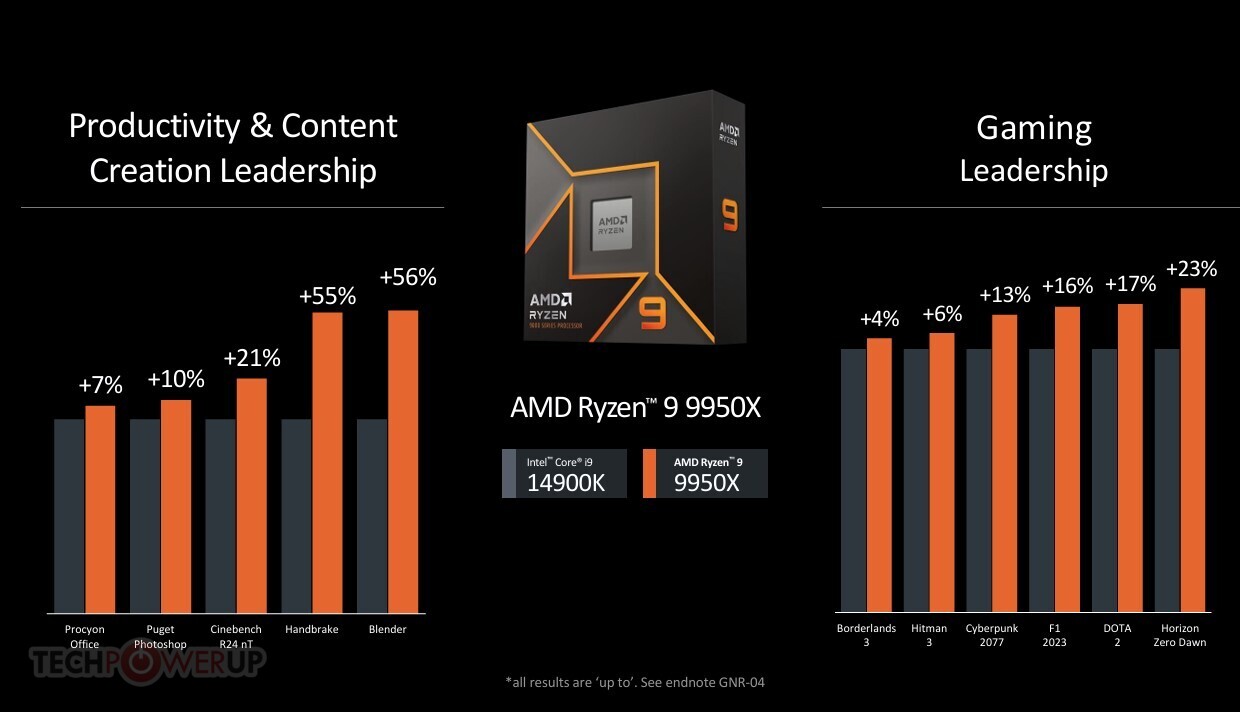https://www.techpowerup.com/323096/amd-zen-5-storms-into-gaming-desktops-with-ryzen-9000-granite-ridge-processors AMD today announced its much awaited Ryzen 9000 series desktop processors. Built in the Socket AM5 package, and drop-in compatible with all current AM5 motherboards with a BIOS update, the processors are based on the new "Zen 5" CPU microarchitecture. The operational part of the processor, the CPU complex dies (CCDs), are built on the 4 nm process, wired to a 6 nm I/O die. AMD didn't get down into the nuts and bolts of the microarchitecture, but briefly mentioned an impressive 16% IPC increase over "Zen 4." Coupled with the fact that the first wave of processors lack 3D V-cache and can sustain higher boost frequencies and TDP, processors in the series should beat the Ryzen 7 7800X3D in gaming performance, which also means that AMD has beaten the 14th Gen Core "Raptor Lake Refresh" processor series by a significant margin.
The 16% IPC increase over "Zen 4" is backed by branch prediction improvements, wider pipelines and vectors, and deeper window sizes across the core design, for more parallelism. The core also features doubling in instruction bandwidth for front-end instructions, FPU to L1, and L1 to L2 data bandwidth, and a redesigned FPU to double AI performance and AVX512 throughput. The company hasn't put out a block design for "Zen 5," and we'll learn more about it in the run-up to the market availability of these chips some time in July 2024.
The "Granite Ridge" processor features a chiplet-based design, just like the Ryzen 7000 "Raphael," Ryzen 5000 "Vermeer," and Ryzen 3000 "Matisse." CPU core counts range from 6-core/12-thread to 16-core/32-thread. The cores are located in CPU complex dies (CCDs). The 6-core and 8-core models feature a single CCD design, while the 12-core and 16-core ones come with a dual-CCD design. Each CCD contains a single CCX (CPU core complex) with 8 "Zen 5" CPU cores. Each core has 1 MB of dedicated L2 cache, and the eight cores share a 32 MB of L3 cache.
The client I/O die (cIOD) appears unchanged from the previous generation. It's built on the 6 nm process, packs a basic iGPU based on the RDNA 2 architecture with 2 compute units; a dual-channel DDR5 memory controller, and a 28-lane PCI-Express Gen 5 root complex.
AMD has planned four processor models for the first wave of Ryzen 9000 series desktop processors. These are led by the Ryzen 9 9950X, a 16-core/32-thread chip with a maximum boost frequency of 5.70 GHz, and a TDP of 170 W. This is followed by the Ryzen 9 9900X, a 12-core/24-thread part that boosts up to 5.60 GHz, with an interesting TDP number of 120 W. If you recall, its predecessor, the Ryzen 9 7900X, had the same 170 W TDP as the 16-core 7950X. So the TDP has generationally lowered.
The Ryzen 7 9700X is the 8-core/16-thread part from the series, with a maximum boost frequency of 5.50 GHz, and an impressive 65 W TDP. The most affordable part from the series will be the Ryzen 5 9600X. This 6-core/12-thread chip boosts up to 5.40 GHz, and has 65 W TDP.
If you're wondering whether the maximum boost frequencies and TDP have gone down generationally, it's because AMD has switched over to the slightly more efficient 4 nm foundry node for the CCDs, besides the "Zen 5" microarchitecture providing the 16% IPC gain.
AMD only put out performance numbers for the top Ryzen 9 9950X processor, which it compared with the Intel Core i9-14900K. In productivity and content creation workloads, the company is claiming performance leadership ranging anywhere between +7% in the UL Procyon benchmark, to +56% in Blender. The real story, though, is gaming performance, where the 9950X beats the i9-14900K by anywhere between +4% to +23%. Mistral LLM is shown running 20% faster on the 9950X compared to the i9-14900K.
The company didn't talk about pricing, we'll learn more about it as we near the July 2024 launch.
AMD is launching the AMD X870E and X870 desktop chipsets with these processors, heralding a new wave of Socket AM5 motherboards, which we'll see at Computex. These two chipsets standardize USB4 connectivity on all motherboards, as well as PCI-Express 5.0 x16 on all boards, even for the X870. The two chipsets also enable higher AMD EXPO memory frequencies. Again, the processors are perfectly compatible with AMD 600-series chipset motherboards with a BIOS update, and older Ryzen 7000 and Ryzen 8000 series processors should work on AMD 800-series chipset motherboards. AMD is promising longevity for AM5 going beyond even 2027.
I like the fact that AMD promises long support for this socket.
